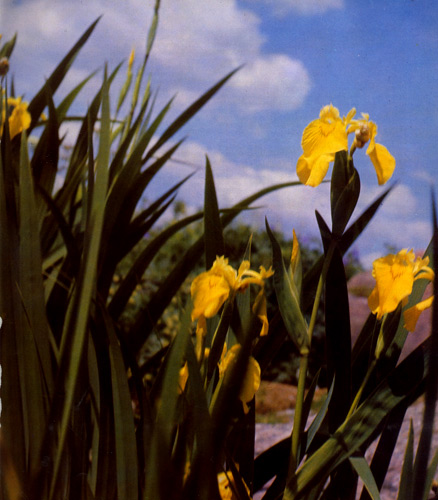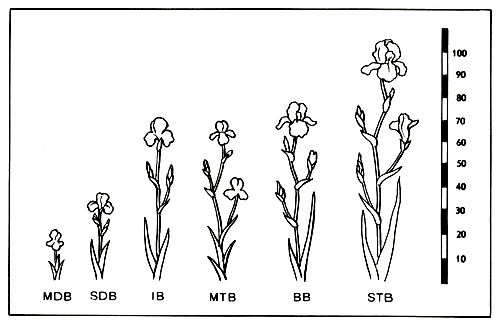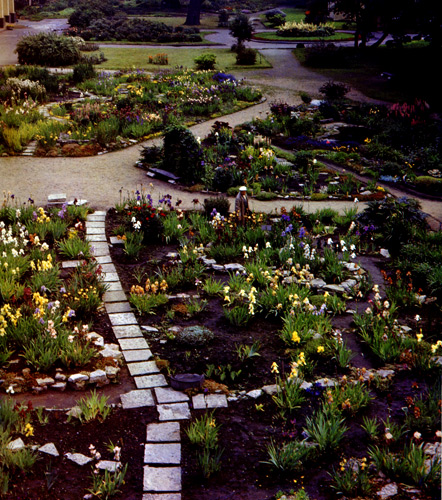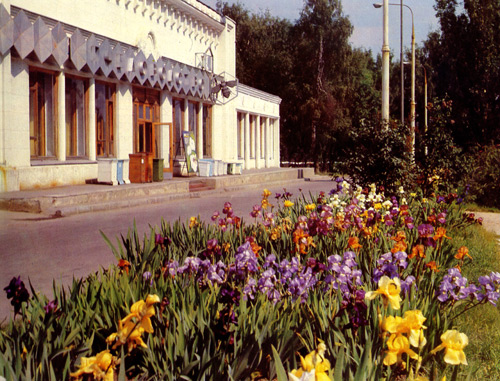
Introduction
Iris have been named after one of the most beautiful natural phenomena (iris means rainbow in Greek). The Russian people have given it the tender name of Kasatik. Ukrainians call the iris "Petushok" (a cockerel) because of its brightly coloured flowers rising above a fan of leaves.

Irises
Iris history goes deep into centuries past. A fresco found in a ruined palace, in Knossos on Crete Island, shows a youth among blooming irises. It was painted about 4,000 years ago, which implies that the rainbow flower has been cultivated as an ornamental plant since antiquity.
Later, iris attracted people with their medicinal properties. For instance, Dioscorides, a Greek physician who served in the Roman army in the 1st cent. A.D., during the reign of Claudius and Nero, referred to the iris as one of the most powerful medicines.
In his book, published in Antwerp in 1576, the botanist Karl Clusius described iris of which a considerable number of species were already known, as decorative plants. Clusius discovered quite a few wild species of exquisite beauty, and was the first to experiment in growing iris from seeds. He was also the first to observe the range of variation occurring in the latter case.

Composition of irises (arranged by N. A. Petrenko and A. N. Zeksel)
Of particular importance for the iris cultivation are the late 19th and early 20th centuries, marked by the work of two British botanists, Michael Foster and William Dykes. The former laid down a scientific basis for hybridization of iris. His persistent efforts were crowned by a qualitatively new group of hybrids, which opened the way to hybridization of polyploid forms. Dykes was the most substantial student of wild iris, which he grew on an experimental plot, each species from a seed and a rhizome. His untiring labour resulted in the publication in 1913 of a lavishly illustrated monograph "The Genus Iris", unparalleled to this day as a reference book summing up the available data on wild species all over the world.
In the 1920s, the centre of intensive hybridization of the garden bearded iris shifted from Europe to the USA. This work was a particular success when taken up by numerous amateurs alongside of professional breeders — an arrangement, indispensable in breeders' work.

1. Iris pseudacorus, a typical perennial of wet meadows
Iris occupy quite a specific place in Japan, that patriarch of iris growing. The number of iris cultivars developed in Japan over several centuries exceeds a thousand, many of them strikingly beautiful, especially when planted around ponds, which produces an unforgettable impression on those who see the flowers.
In the 20th century iris are popular not only in Japan, the USA and Canada, but in most West-European countries, Australia and New Zealand as flowering and deciduous decorative perennials. Dozens of richly illustrated books, and hundreds of bulletins of floricultural societies are written on the subject, and international symposia and congresses held.

2. Classification of garden iris by the flower size and stalk height
By the number of cultivars, which exceeds 30,000, this perennial flower ranks first among cultivated plants.
The iris is new for Soviet flower-growers. The flower attracted their attention only after World War II. Intensive research was started in 1947 at the Botanical Garden of the USSR Academy of Sciences Institute of Botany (Leningrad), on the initiative of G. I. Rodionenko, one of the authors of this book. In 1962, the first Soviet iridarium was established. Over 7,000 specimens of the Iridaceae genus have been tested there, and scientific principles of a new classification of Iris have been developed. For this work G. I. Rodionenko was elected Honorary Member of the British Iris Society and awarded the Michael Foster Medal, the highest prize of the Society.

3. The Iris garden at the Botanical Garden of the USSR Academy of Sciences Institute of Botany, Leningrad
It may be said without any exaggeration that the iris is a unique plant, with a potential still insufficiently studied.
The flower has an unusual structure, with petals open in such a way as to expose their every spot. When lighted with slanting sunrays or electric light, they seem to be dusted with fine diamond powder, due to a peculiar structure of petal skin cells focusing light like miniature lenses.
The leaves, rhizomes and even roots of iris possess different useful properties. The rhizome of Iris florentina, and of some hybrid forms contain iris oil and a specific substance with a faint, violet-like fragrance, both indispensable in the perfume industry.
The decortexed and sun-dried rhizomes of these iris are named orris root. It has been produced in the vicinity of Florence for more than 300 years.

4. Irises in front of the cinema "Oktiabr" in the town of Zhitomir
Large thickets of I.songarica have been found in Soviet Central Asia, east of Samarkand and elsewhere. Uzbek botanists have discovered that the rhizomes and roots of the iris contain a substance possessing anticeptic properties. Its leaves produce an extremely strong fibre used in brushes.
The leaves of most species of iris are rich in vitamin C, and can be used in vitamin industry.
Phytoameliorating properties of the root system of some iris species and possibilities of their utilization to improve heavy and salinated soils are under study.

5. Groups of irises near the pavillion "Apiculture" at the Exhibition of the National Economic Achievements, Moscow
Most botanical gardens of the USSR — and there are more than 100 all told — now have rich collections of recently selected cultivars. The success of amateur gardeners is considerable too. Hence, it may be said that the first stage of Soviet gardeners' work with this new plant, i. e. collecting an adequate stock of cultivars, is over. Now, it is high time to evaluate both decorative and biological properties of the introduced cultivars: their propagation capacity (bush expansion), winter-hardiness, tolerance to high and low temperatures and soil salinity, as well as pest and disease resistance.

6. Iris pallida
The future of any plant including iris depends to a great extent on gardeners' interest in developing home cultivars. There is in the USSR a group of iris breeders engaged in hybridization. One may see their first achievements for oneself in this book.

7. Iris klattii
|
ПОИСК:
|
© FLOWERLIB.RU 2001–2022
При использовании материалов активная ссылка обязательна:
http://flowerlib.ru/ 'Библиотека по цветоводству'
При использовании материалов активная ссылка обязательна:
http://flowerlib.ru/ 'Библиотека по цветоводству'